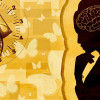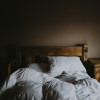Getting enough sleep is vital for health and wellbeing. Unfortunately, it’s not always easy to do...
Many of us regularly struggle to get enough sleep, and while some of this is due to busy lifestyles, there are also times when we do go to bed on time, but just can’t drop off. And it seems to be getting worse, thanks to the stress and changes in routine caused by the coronavirus pandemic. One survey found that levels of insomnia rose from 15% before the pandemic to 24% during the April 2020 lockdown. So what is going on in our brains to cause these problems? While we don’t understand it fully, we are starting to pick apart the networks involved in sleep. And the beginnings of this understanding goes back to the First World War.
In 1916, a strange disease began to present itself in Vienna. Patients suffered from a short, acute illness, feeling generally unwell with a headache and a mild fever. But then they would start to feel sleepy and confused, beginning to spend less and less time awake. Many also experienced tremors and weakness of the hands or eye muscles. After a couple of weeks of these symptoms, around half of people would recover while others would fall further and further into sleep. Where at first they had been easy to rouse, over days or weeks they would become more delirious during their short periods of wakefulness, before slipping into a coma. Death would often follow.
At this time, a young man was working as a pilot on the front line for the Austrian air force. His name was Constantin Von Economo, and he was the youngest child of a Greek aristocratic family. Von Economo was a doctor, and so, pressured by his parents to stay out of danger, he moved to Vienna to work as a military physician caring for people with head injuries. It was here that he first saw patients with this mysterious illness. Realising this was something mostly unknown to science, he wrote a paper describing the disease in 1917 and giving it the name ‘encephalitis lethargica’, although it was more commonly known as ‘sleepy sickness’.
As well as the drowsy type, he documented two other manifestations of the illness, each with its own constellation of symptoms. One form made patients restless, with physical twitches and mental frenzies as well as severe pain and, often, insomnia or a reversal of the normal sleep pattern. In some cases, this form later turned into the sleepy form, but sudden death could also occur at any stage. The symptoms of the third type were similar to those of severe Parkinson’s disease, with weakness and rigidity in the muscles a prominent symptom.
Von Economo was fascinated. He wanted to know what was causing this range of symptoms so he began analysing the brains of people who had died of the disease. He soon realised that these patients, with their severe sleep disturbances, could tell us something about how sleep is controlled in the brain. He noted that his lethargic patients had damage to the back part of an area in the brain called the hypothalamus, while in people with insomnia the damage occurred further forward in the hypothalamus, near the optic nerve. He argued that these two areas were the ‘sleep part’ and the ‘waking part’ of the brain, and that neurons in these centres would initiate a chain of events to damp down or ramp up activity in the cortex, allowing us to transition from wake to sleep and back again.
It is thought the illness killed a million people in around 10 years, but the cause of ‘sleepy sickness’ is still a mystery. Von Economo thought it was linked to the severe flu outbreak that was happening at the time, but more recent analysis hasn’t supported a direct link. But no other definitive cause has been found. Some researchers argue that it is an autoimmune disease, where the body itself attacks and breaks down brain cells, perhaps triggered in some by the flu infection. Others believe an as-yet unidentified virus was to blame. Fortunately, the disease has all but disappeared, but this means there is very little chance of solving the mystery, unless sleepy sickness rears its ugly head again in the future.
He may not have discovered why people developed the illness, but when it comes to his findings about sleep, Von Economo was right on the mark. The regions of the hypothalamus he documented are vital for the transition to and from sleep. However, scientists now know these are just one component of sleep and wake networks. These spread throughout different areas of the brain from the brainstem at the base to the cortex on the surface, and each use a different combination of chemicals.
The sleep network, when activated, releases GABA into the cortex. Here it inhibits the neurons, making them harder to activate. This causes neurons in the cortex to fire less, calming you down ready for sleep. These neurons originate in a part of the hypothalamus which sits right in von Economo’s sleep centre. The wake system uses a wide range of neurotransmitters, including dopamine, noradrenaline, serotonin, glutamate, histamine and, perhaps most importantly, acetylcholine, which activates neurons in the cortex, to make us feel awake and alert. All of these complex pathways pass through the hypothalamus at some point on their journey, right through the area von Economo called the ‘ wake centre ’. You can think of sleep and wake as a see-saw. When we fall asleep or wake up, our brain must flip the ‘switch ’, and tilt the see-saw.
But how does the brain know when to flip us from wake to sleep? There are at least two processes that help it decide. One is our body clock, which tells us the time of day. During the day, bright light is detected by special cells in our eyes, which send signals to a brain region called the suprachiasmatic nucleus (SCN). This initiates a cascade of changes that make us feel awake and alert. Later in the day, as the light begins to dim, this information too is carried to the SCN, which again initiates changes to make us feel sleepy, including the release of a chemical called melatonin. Though research on its mechanisms is only just beginning, some studies have found that melatonin appears to block some of the neurons in the ‘wake centre’, helping you slip into sleep more easily.
The other factor is how long you have been awake. This is driven by a chemical called adenosine, which is a by-product of the metabolic processes our cells undergo all the time when we are awake, so it builds up throughout the day. The more of it there is sloshing around in an area of the brain called the basal forebrain, the higher our ‘sleep pressure’ and the more likely we are to drop off.
It is the adenosine system that so many of us trick with our daily dose of caffeine. When adenosine levels are low, acetylcholine is released in the basal forebrain, making us feel awake and alert. Adenosine prevents the release of acetylcholine, so we feel sleepy. But caffeine blocks the receptors that are normally triggered by adenosine, making it seem to our brains that the concentration is lower than it actually is. This, in turn, means more acetylcholine is released, activating neurons in the cortex and making us feel more alert.
It's clear the systems that control sleep and wake are highly complex, involving a huge number of different brain areas and chemicals. So perhaps it’s not surprising it doesn’t take much to change these processes and cause problems with dropping off. But, unfortunately, while we are starting to understand how our brains move from a state of wake to a state of sleep, this hasn’t really led to any revolutions in improving individual sleep quality.
Supplementing with melatonin might benefit older people, whose circadian rhythms are blunted, as well as people with disorders of their body clock. And there are various types of sleeping pills, which can be helpful for people with clinical insomnia. But these are usually only recommended as a short-term solution, to be used for the odd bad night, not every day.
So if you do have problems with sleep, is there anything you can do? It seems that the best techniques are behavioural ones. You might focus on getting bright light in the morning to set your circadian rhythm for the day, and avoiding it late at night. It might help to eat earlier in the evening, and take some time to wind down before bed, doing breathing exercises or listening to a relaxing audiobook to reduce stress. You can make sure your bedroom is set up optimally- dark, cool and quiet. And trying to stick to a routine, even when working from home, can make a difference too. These tricks might not cure insomnia in all cases, but for many of us they just could be the difference between a good and a bad night’s sleep.
Overloaded, by Ginny Smith, is out from April 2021









Comments
An outstanding read... thank
An outstanding read... thank you!
Add a comment